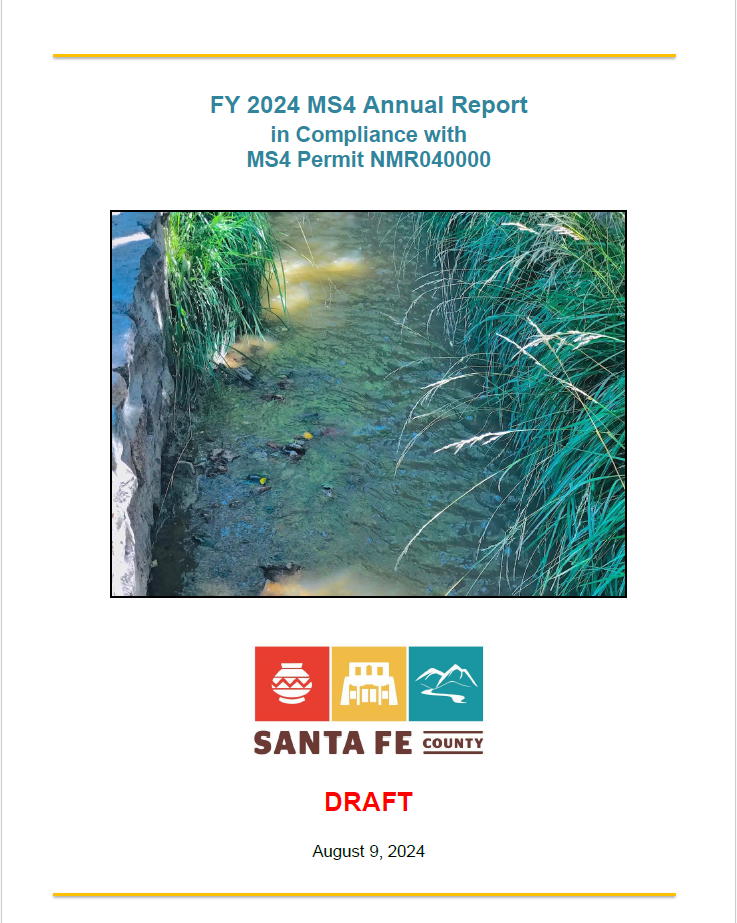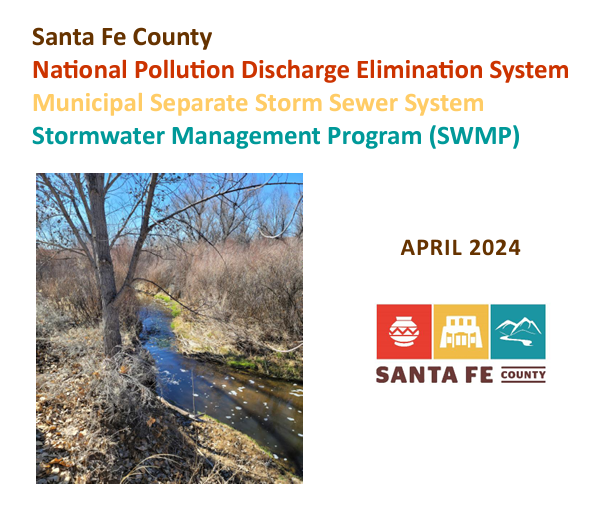Conserve Water
When we use less water, we help protect our local water resources and meet current and future needs more sustainably. Since groundwater and surface water are interconnected, using less groundwater means more water for the creeks, springs, rivers, and ecosystems in New Mexico.
Firescaping with Green Stormwater Infrastructure (GSI) and Plant Selection
Passive stormwater catchment in rain gardens near buildings and homes can have numerous benefits including improved soil moisture for plants that help cool/shade. Healthy soil and habitats provide lower wildfire risk. In Wildland Urban Interface (WUI) areas prone to fire however, some considerations about the proximity and density of plant fuels near buildings should be made. The careful selection and placement of plant species and the integration of Green Stormwater Infrastructure (e.g. rain gardens) can work to both reduce water use and create a defensible space around your home helping to modify the intensity and impact of wildfire.
Included below are helpful resources to determine if your home is within a Wildfire Urban Interface Area, principles to establish defensible space around your home, and how to select plants resistant to wildfire.
FY24 MS4 Annual Report Submitted to EPA
Santa Fe County is requesting public review of the draft municipal separate storm sewer system (MS4) annual report required under the National Pollutant Discharge Elimination System (NPDES) General Permit for Discharges from Small MS4s, permit number NMR040000. The report, which has been submitted to the United States Environmental Protection Agency (EPA), describes Santa Fe County activities between 2023-2024 to manage stormwater pollution and comply with MS4 permit conditions.
A copy of the draft report is available for public review below (digital copy) and at 240 Grant Avenue, Santa Fe, NM 87501 (physical copy).
Comment period closed
(Click the image above to open a PDF of the document)
Why save water?
In most parts of Santa Fe County, the groundwater aquifers were filled thousands of years ago; the drop we use today is not likely to be replenished.
Saving water also saves you money! Regardless if your water source is a well or a utility, using less water means more money in your pocket! If you are on a well, conserving water saves on the electric cost to pump water and on the wear-and-tear of your pumping infrastructure.
How much water do I use?
The simplest way to calculate your residential water use is to standardize it on a per-person, per-day basis. By taking the amount of water on your water bill and dividing it by the average number of days in a month (30.4 days), then dividing it by the number of people in your household, you can estimate your gallon-per-person-per-day use. Do you use less water than the average Santa Fe County utility user, who uses 59 gallons-per-person-per-day?
If your water comes from a well, you can use your well meter reading instead of your water utility bill. Divide the total gallons used by the number of days between the two readings, then divide by the number of people in your household for your gallons-per-person-per-day.
Another option is to estimate your customized water use based on your home appliances and uses.
Interesting Fact: Almost everything we use in our daily lives has a water footprint, from the food we eat, to the fuel for our cars, the electricity for our gadgets, and the clothes we wear. These two websites can calculate your total water footprint:
How can I save water at home?
Although habits—like taking shorter showers—do reduce water use, the most effective way to save water is by installing water-saving, EPA-certified WaterSense faucets, shower heads, toilets, dishwashers, and washing machines. Since more than half of residential water use comes from flushing, your toilet is a great place to start: check for leaks and replace the toilet if it uses more than 1.6 gallons per flush. Stop by Santa Fe County Public Work Department at 424 Highway 599 W. Frontage Road to pick up your free leak-detecting toilet dye tablets or use your own dye.
Outdoor landscaping also provides many opportunities to save water.
Here are some of our favorite websites on how to save water at home:
- Home Water Conservation Tips from HomeWaterWorks
- The Complete How-To-Guide to Xeriscaping, New Mexico Office of the State Engineer
- New Mexico's Interactive Plant List
- EarthEasy's 45+ Ways to Save Water in Your Home and Yard
- Permaculture tips for New Mexico, New Mexico Magazine
- Calculating Water Loss from Leaks from the American Water Works Association
Leaking Toilets: Testing and Fixing
Does your toilet leak? Here is an easy way to check and you can pick up free leak dye tablets at Santa Fe County Public Works complex. If you've determined you have a leaking toilet, most fixes are fairly simple, and there are many resources on the web, like:
Taking care of your domestic well
When a well is drilled, that well becomes directly connected to the groundwater aquifer, whether groundwater is shallow (less than 50 feet below the ground surface) or deeper. When that well is pumped, it pulls in water from all of the surrounding rocks in the shape of a cone or funnel, connecting your well to the groundwater shared by your neighbors. For more information on the most recent La Cienega & la Cieneguilla well-monitoring initiative, please view our 2023 report.
Here are some tips to protect your and your community’s groundwater supply:
- Shield your wellhead area.Keep pesticides, fertilizers, pet and animal waste, septic system drain fields, dump sites, and compost piles at least 100 feet away from your well.
- Slope the ground.Make sure the ground around your well is higher than the surfaces nearby, to keep surface water from running down along the casing and into your water supply.
- Inspect your well annually.Assure there are no gaps between your well cap and well casing where surface water, insects, or rodents can enter the well and contaminate your water supply. Look for visible cracks to the casing, or damage to the well cap and other well components.
- Test the well water quality periodically. The New Mexico Environment Department has water testing fairs periodically throughout New Mexico. The Environment Department tests your water sample for pH, electrical conductivity, nitrates, iron, sulfate, arsenic, and fluoride. Visit the Environment Department's website periodically to find water quality fairs in your area.
- Maintain well records. Keep and update records about your well including your annual meter readings, your New Mexico Office of the State Engineer well permit, your well (drilling) log, water quality test results, a log of maintenance work performed, and Santa Fe County water use restrictions. Some of this information is available through the NM Office of the State Engineer Water Lookup website, and restrictions on your well may be identified on your property plat. You can submit your domestic well meter readings to Santa Fe County using the Meter Reading Reporting Form.
The water-energy nexus
Water is critical in producing the energy we use to keep our homes comfortable and to fuel our transportation. In oil and gas development, water is used for extraction and is produced as a by-product. In electricity generation, barrels of water are heated to high-pressure steam to drive turbines, which is recovered in closed-loop systems. Water is also used to manufacture solar panels and wind turbines for renewable energy. Using less energy and less fuel also saves our water resources. Read more about the challenges and opportunities of the water-energy nexus (US Department of Energy, The Water-Energy Nexus).
Water quality and stormwater management
What you can do!
If you have ever stepped outside as the snow is melting or trekked through the summer rain, you have likely noticed water flowing off roofs through canales and gutters, across parking lots, over sidewalks, and along roadways. Runoff is generated as water moves over impervious surfaces rather than seeping into the ground. As it moves across the landscape, runoff washes pollutants, such as oils, bacteria, chemicals, and trash, into waterways.
Every drop of water counts in our dry climate. Here are a few steps you can take to beautify our community and protect local waterways from runoff pollution:
- Keep your yard and the community clean: Pet waste left in your yard, along sidewalks, and in parks can wash into waterways where it introduces bacteria and other pollutants that pose a threat to humans and the environment. Be sure to clean up after your pet at home and in community areas. Consider attaching waste bags to your pet’s leash so you are always prepared. Similarly, runoff can also transport litter into waterways. Securely store and properly dispose of all trash and recyclables to prevent this.
- Store the water for a not-so-rainy day: Santa Fe County receives an average of just 15 inches of precipitation annually. Investing in rainwater catchment systems, such as cisterns and rain barrels, allows you to save this precious water for later use. Plus, these systems reduce the amount of runoff that might transmit pet waste, fertilizers, motor oil, and other pollutants from your property into waterways. Click here to view Chapter 7.13.11.7 of the County’s Sustainable Land Development Code to learn about water catchment requirements.
- Create a rain garden: Create an oasis for people, birds, and butterflies by redirecting runoff from your roof or driveway into a rain garden. Rain gardens help to soak up water and filter pollution from runoff. Click here to view examples of rain gardens around Santa Fe.
Stormwater runoff management throughout Santa Fe County
To protect water quality, the federal National Pollution Discharge Elimination System (NPDES) program requires a permit to discharge stormwater to municipal separate storm sewer systems (MS4s). MS4s include publicly owned or operated streets, catch basins, ditches, storm drains, culverts, and other stormwater conveyances. The unincorporated urbanized areas of Santa Fe County fall under permit number NMR040000, which is currently under administrative continuation by the Environmental Protection Agency (EPA). This permit includes the City of Santa Fe and the New Mexico Department of Transportation. Permittees are required to maintain a stormwater management program that addresses six minimum control measures and report annually to EPA on that program. The minimum control measures are as follows:
- Public education and outreach on stormwater impacts
- Public involvement/participation
- Illicit discharge detection and elimination
- Construction site stormwater runoff control
- Post-construction stormwater management in new development and redevelopment
- Pollution prevention/ good housekeeping for municipal operations
Proper stormwater management is critical to prevent unnecessary erosion and promote soil moisture retention. The Santa Fe County Board of County Commissioners passed resolution 2024-064 on April 30th, 2024 adopting the Santa Fe County 2024 MS4 Permit Stormwater Management Program Plan.
In Santa Fe County, stormwater management is distributed across the Public Works Department, Growth Management Department, and Sustainability Office. The Public Works Department’s MS4 responsibilities include stormwater management on County roads, facilities, solid waste convenience centers, and construction sites. The Growth Management Department’s responsibilities include code enforcement actions to ensure stormwater protection measures are in place, construction and development plan review, public education, and administration of stormwater codes. The Sustainability Office handles public education and outreach through activities such as the County Adopt-a-Road Program and Earth Day events, contributing to the County’s 30x30 initiative.
Contact
Jacqueline Beam
Sustainability Manager
jybeam@santafecountynm.gov
(505) 992-9832


